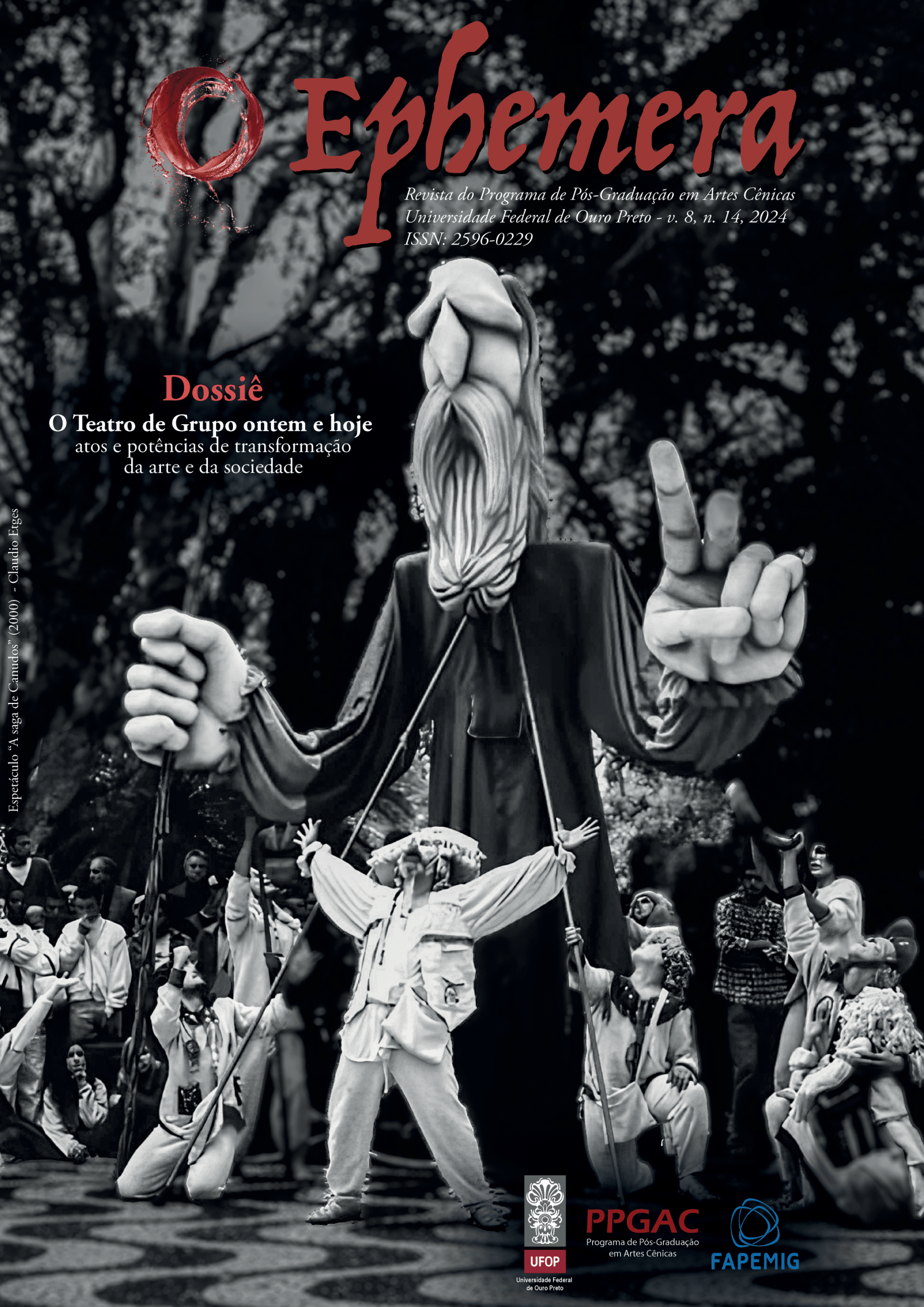"The woman and the drain"
body, death, madness, vomit, excretions and deliriums
Abstract
The article analyzes the medium-length film “A Mulher e o Ralo”, produced during the Covid-19 pandemic, addressing themes such as death, madness and the degradation of affections. The work reflects on the emotional impact of the pandemic period, using a visceral aesthetic to portray the destruction of bodies and the fragmentation of subjectivities. Exploring the collapse between life and art, the film mixes video and photo-performance, creating a choreographic and poetic narrative about the female psyche and its relationship with the body in crisis. The analysis methodology is based on the performance theories of Stella Fisher and Eleonora Fabião, André Lepecki's concept of phantasmagoria, Antonin Artaud's aesthetics of cruelty and Michel Foucault's historical-cultural understanding of madness. The article examines how these theoretical references help to understand the process of deconstruction and reconstruction of bodies and affections throughout the film's four scenes. Each scene, with its independent aesthetic, reflects a unique poetic and visual invention, linked to the larger narrative of fragmentation, excretion and madness. The analysis also focuses on the artistic experimentation that emerged from the need to adapt scenic practices to audiovisual, breaking boundaries between physical and virtual presence.
Downloads
References
A MULHER e o ralo. Produção: Camila Nogueira. [S. l.]: TRÍADE ARTE COLETIVA, 13 jan. 2021. 1 vídeo (20:04min). Disponível em: https://www.youtube.com/watch?v=-nq_9cWrk2A&rco=1. Acesso em: 23 fev. 2025.
ARTAUD, Antonin. O teatro e a Ciência. In: VIRMAUX, Alain. Artaud e o Teatro. São Paulo: Perspectiva, 2000.
ARTAUD, Antonin. Carta aos Médicos-Chefes dos Manicômios. In: Escritos de Antonin Artaud. Tradução de Cláudio Willer. Porto Alegre: L&PM Editora, 1983.
FABIÃO, Eleonora. Performance e teatro: poéticas e políticas da cena contemporânea. Revista Sala Preta, São Paulo, nº 8, p. 235-246,2008. Disponível em: http://www.revistas.usp.br/salapreta/article/view/57373. Acesso em: 23 fev. 2025.
FABIÃO, Eleonora. Programa performativo: o corpo em experiência. ILINX Revista do Lume, Campinas, n. 4, p. 01-11, 2013. Disponível em: https://orion.nics.unicamp.br/index.php/lume/article/view/276 . Acesso em: 23 fev. 2025.
FISCHER, Stela. Por que fazemos performance e ativismo feminista?, Revista Arte da Cena, Goiânia, v. 3, n. 1, p. 08-20, 2017. Disponível em: https://www.revistas.ufg.br/artce/article/view/46166 . Acesso em: 23 fev. 2025.
FOUCAULT, Michel. Sexualidade e Solidão. In: FOUCAULT, Michel. Ditos e Escritos, volume V: ética, sexualidade, política. 3. ed. Rio de Janeiro: Forense Universitária, 2012. p. 91-101.
FOUCAULT, Michel. História da Loucura: na idade clássica. São Paulo: Perspectiva, 2014.
LEPECKI, A. Planos de composição. In: GREINER, C.; SANTO, C. E; SOBRAL, S. (org.). Cartografia: Rumos Itaú Cultural Dança, 2009-2010. São Paulo: Rumos Itaú Cultural, 2012. p. 13-22.
LIMA, Daniela. Corpo-vetor e corpo-utópico. N-1 edições, [s. l.], 2020. Disponível em: https://www.academia.edu/43221793/Corpo_vetor_e_corpo_ut%C3%B3pico . Acesso em: 32 fev. 2025.
MOURA, Heleniara Amorim. A mulher e o ralo. In: MARTINS, Oswaldo (org.). Clube dos mestres, aprendizes e curiosos. 1. ed. Rio de Janeiro: Editora Texto Território, 2023, p. 53-55.
PINHO, Armando F.; OLIVEIRA, João Manuel. O olhar político feminista na performance artística autobiográfica. Ex aequo, n. 27, p.56-76, 2013. Disponível em: http://www.scielo.mec.pt/scielo.php?script=sci_arttext&pid=S0874-55602013000100005. Acesso em: 23 fev. 2025.
Copyright (c) 2025 Heleniara Amorim Moura, Marina Freire Brandt

This work is licensed under a Creative Commons Attribution-NonCommercial 4.0 International License.
O/As autore/as mantêm os direitos autorais sobre os documentos publicados pelo periódico e cedem ao periódico o direito de publicação dos textos e de seus metadados (em múltiplos suportes e formatos), inclusão em bases de dados e assinatura de acordos de indexação atuais e futuros (mesmo com licenças menos restritivas, para os textos, ou sem restrições, para os metadados), de modo a garantir a indexação do documento publicado e de seus metadados.
O documento publicado será distribuído nos termos da Licença Creative Commons Atribuição - Não-Comercial 4.0 Internacional (CC-BY-NC) que permite o uso, a distribuição e reprodução em qualquer meio desde que sem fins comerciais e que o artigo, os autores e o periódico sejam devidamente citados.



